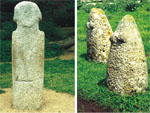
Single
stone:
menhir is a single stone, but this is not an architecture
yet
(Menhir in Corse, France; Tamuli in Sardegna, Italy) |
|
Beginnings
reach several millennia back, into prehistory, from which
megalith structures are known. They are "large stones"
that stand independently or in rows, in walls or forming shelters.
The menhir as an important stone isn't architecture, although
it is designed. With a beam its' utility increases, corbelling
allowed the creation of enclosed spaces, the Etruscans introducing
the arch and Romans developing it further into spatial constructions
the cupola.
Technically speaking development
runs logically from the simplest solutions to more demanding
ones, which offer more.
The menhir as a stone doesn't represent
architecture as such. It is only a spatial landmark.
The taula is part of larger spatial
compositions, technically positioned between the menhir and
dolmen. It is a sort of column with a capital.
The dolmen itself is a structure of two vertical stones with
a beam, which together function as a simple object. More important
is the row, when several dolmens form a longitudinal place.
At the end of the "corridor" is a space, usually
a rough cell, at first covered by a large slab and later with
smaller corbelled stones. Later the arch was developed
and only much later, during the renaissance, the cupola emerged,
which was however already seen on the Pantheon. Stone monuments,
such as menhirs are most often seen in Brittany and Corsica,
where they are already designed, while in Sardinia they are
known as tamuli and have abstract shapes.

| The
first known arch: Etruschan architecture from
the first Millennium BC (Volterra, Italy) |
|
In Menorca the "recinte de
taula" are joined objects serviced by a central column.
Typical corbelling first emerged
as the construction for sanctuaries (Hal Saflieni and Hagar
Qim in Malta, tumuli in Ireland, Britanny and Italy), as well
as in burial architecture (naveta in Menorca) and as military
systems in the Nuraghi culture of Sardinia. Proven beginnings
reach back to some five thousand years BC.
|